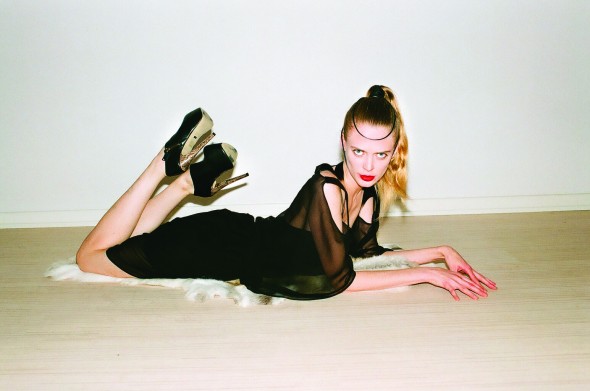
The Berlin-based label Don’t Shoot the Messengers (DSTM) has an immediately recognizable aesthetic, articulated through sculptural and provocative leather accents, delicate sweeping silk, and, above all else, the color black. It’s a label in constant dialogue with the designer’s adoptive city and Berlin’s notoriously avant-garde disciples.
Jen Gilpin, DSTM’s 34-year-old Canadian founder, established the label when she arrived in Berlin five years ago. Now, with the opening of her new boutique (and adjacent open workshop) in Berlin’s increasingly “luxus” neighborhood of Mitte, Gilpin and DTSM are fast becoming ubiquitous among the city’s most decadent style tribes.
“The base of the line is silk and leather,” says Gilpin. “I like this contrast of soft and hard, we pull it through the collections with the materials and the attitude. There is a sort of tough elegance that we strive for and find beautiful in the women we dress.”

Sharp, defined silhouettes in leather and heavy wool, and refined, feminine layers of cashmere and silk constitute the majority of DSTM’s women’s wear. Their menswear is decidedly structured, but that’s not to say rigid. Loose-fitting jerseys under minimal, leather harnesses—a progressive riff on the classic suspender. As with DSTM’s women’s wear, each piece is a haptic experience, meant to entice the body’s innate response to the materials used, especially leather. Gilpin explains, “Leather is grown, not made. It is skin. We feel naturally connected to it.”
The label is expanding its line of body wear, a signature of the DSTM aesthetic and its almost dangerous degree of seduction (DSTM does, after all, recall another four-letter anagram: BDSM). Crisp lines and shapes in alternating materials—opaque and sheer—accentuate the body’s natural and most attractive angles. “Geometry in relation to the body is key for us,” explains Gilpin. “What we want is to make clothes that are molten, elegant, sexy, and just a little bit rock and roll.”
DSTM’s growing body wear range also allows Gilpin and her team to challenge their own design precedents unencumbered by seasonal style constraints. “With this range we are interested in doing collaborations with other artists and companies, and experimenting with new materials, techniques and bio performance fibers.”
In Berlin, the creative process is constantly on display. It’s integral to the city’s evolution where its artistic aspirations flow freely into the streets, like some kind of intoxicating nectar, from the countless artist studios, designer workshops, and concert venues where the buds of contemporary culture are coerced into being. DSTM is no exception.
Says Gilpin, “I love Berlin. It has the best quality of life and freedom out of any other city I have lived in or visited. There is such a great community of international artists that are a constant source of inspiration…and I love the fact that people can come into the shop and also see where and how everything is made.” This transparency breeds creative collaboration, an ethos Gilpin embodies in both her professional and personal lives, which, like most creatives, are more than mutually inclusive: They are one and the same.
Gilpin’s husband and DTSM’s image director, 29-year-old French photographer Maxime Ballesteros, has been developing a cult following in his own right. An inexhaustible chronicler of Berlin’s lost generation, its aspiring artists, designers, and the scene’s myriad protagonists, Ballesteros is an integral contributor to DSTM’s increasing visibility and growing reputation.
His work has been exhibited at Galerie Mikael Andersen in Berlin and seen in the editorial pages of high-culture publications like Purple Journal, 032c, Monopol, and Interview Magazine Germany. In his book, A Sense of Direction, Gideon Lewis-Kraus writes of Ballesteros that he “shot the kind of harsh and tender photographs one might have seen on Nan Goldin’s Facebook page.” Harsh and tender: A maxim perfectly encapsulated by DTSM and embodied by Gilpin and Ballesteros’ artistic collaboration. Where to buy: evanewyork.net, internationalplayground.com, weltenbuerger.org
Text by Emilie Trice

